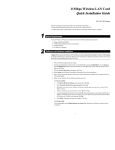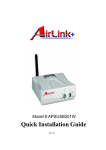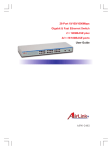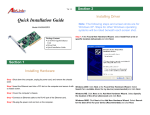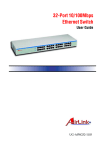Download Airlinkplus RT211W Installation guide
Transcript
Ver. 5A Quick Installation Guide This Quick Installation Guide only provides you with some basic instructions. For more detailed information, please refer to the User Manual on the supplied CD. Model # RT211W Package Content: • 802.11g access point • Power Adapter • Category 5 UTP cable • Utility CD • Quick Installation Guide 1 Connecting the Access Poing (AP) Prior to connecting the hardware, make sure to power off your Ethernet device, Cable/ADSL modem and AP. Then follow the steps below to connect the related devices. Step 1 Connecting the power adapter. Connect the single DC output connector of the power adapter to the power jack on the back of the AP. Then connect the supplied power cord to the power adapter and the other end to an AC outlet. Step 2 Connecting to Ethernet network. Attach one end of the Ethernet cable with RJ-45 connectors to your hub, switch or a PCs Ethernet port, and the other end to the LAN port of your AP. Setting Up Ethernet/WLAN Client 2 You can choose to access the APs Web interface via Ethernet or wireless network. Whatever your choice, you must properly configure the network settings of your PC to be in the same subnet with the AP. As the AP is shipped with these defaults: • IP address: 192.168.1.1 • Subnet mask: 255.255.255.0 • DHCP server: Disabled Therefore, you should configure your PC’s TCP/IP settings to use a static IP as below: • IP address: 192.168.1.x (x is between 2 and 254) • Subnet mask: 255.255.255.0 • Gateway: 192.168.1.1 Note: Before you change the TCP/IP configuration, you should write down your original configuration setting in case you need to restore it later. Step 1 Click the Start button. Select Settings and/or click the Control Panel icon. For Windows 98 and ME, double-click the Network icon. For Windows 2000, double-click the Network and Dial-up Connections icon. Double-click the Local Area Connection x. For Windows XP, click the Network and Internet Connections icon. Click the Network Connections. Double click the Local Area Connection x under LAN or High-Speed Internet. Note: snap shots are for Windows 2000 and XP Step 2 For Windows 98 and ME, Select “TCP/IP -> Your Ethernet Adapter”, Click the Properties button. Go to step 4 If you choose to manage the AP via a wireless client, please also check the following: 1. Make sure your PC is equipped with 802.11g or 802.11b wireless adapter and has appropriate WLAN card driver / utility and TCP/IP installed. 2. Set the wireless adapter to use appropriate TCP/IP settings as described in previous section 3. Launch the wireless adapter’s provided utility and verify that your wireless client is configured with these settings: • Operation Mode: Infrastructure • SSID: 11g AP • Authentication: Open • WEP Mode: Disabled For Windows 2000 and XP, click the Properties button in the Local Area Connection Status window. 3 Step 3 For Windows 2000 and XP only, Make sure the Internet Protocol (TCP/IP) is checked and highlighted in the Local Area Connection Properties window. Click the Properties button. Checking the Connection to the AP After configuring the TCP/IP protocol, you can use the ping command to verify if your LAN/Wireless computer has successfully connected to the AP. To execute ping command, open the DOS window by clicking on Start -> Run. In the Run window, type Command. At the DOS prompt, type the following command: ping 192.168.1.1 Step 4 For Windows 98 and ME, select Specify an IP adress and fill the fields below with the values mentioned above in the TCP/IP properties window. For Window 2000 and XP, select Use the following IP address and fill the fields below with the values mentioned above in the Internet protocol (TCP/IP) properties window. Step 5 Click the OK button and restart the computer. If the Command window returns something similar to the following: Reply from 192.168.1.1 bytes=32 time=100ms TTL=253 Then the connection between the AP and your computer has been successfully established. If the computer fails to connect to the AP, the Command window will return the following: Request time out Veryfy your computer's network settings are correct and check the cable connection between the AP and the computer. Continue on back... 4 Accessing the Web-Based Configuration Utility Step 1 Start your Web browser and type http://192.168.1.1 in the URL field. This is your AP's default private IP address. Step 2 After connecting to the device, you will be prompted to enter the username and password. Leave the username empty and enter the default password as admin. Manually Specifying an IP address If you want to reconfigure the IP information of the AP to match your existed LAN, just pick one available IP address and the same Subnet Mask and Default Gateway for your LAN. Enable the Manual Config option and enter your new settings in the provided fields. Enabling DHCP Server The AP implements a built-in DHCP server which can be used to dynamically assign IP addresses to the DHCP clients on the LAN/WLAN. To use DHCP server function, make sure you have properly set the AP’s IP address, enable the DHCP service, then enter the DHCP Lease Time and IP Pool Range fields. Step 3 The Web-Based utility will appear with the System Overview table selected. Setting the AP to be DHCP Client If your network has already deployed a DHCP server, you should set the AP to be a DHCP client. The AP will request an IP Address from the DHCP server when rebooted or powered up. After you enable the DHCP client option and apply the change, your PC will lose the communication to the AP. Since the IP address assigned to the AP could come from a large DHCP address pool, you will need a third-party tool to identify the APs IP address. 5 LAN Configuration Click the LAN page link to configure the LAN interface. Note: Changing the LAN settings may cause the PC from which you configure the AP to lose the communication to the AP. To reconnect, you will need to reconfigure your PC to use an IP address compatible with the new IP address. 6 Wireless LAN (2.4G) Configuration Click Wireless LAN(2.4G) to configure the wireless settings of the AP. The following describes the basic wireless configurations: Congratulations! You’ve successfully configured your AP. You should custom ize the SSID and Channel settings as needed. For added security, you should enable WEP encryption and firewall following instructions from the manual included in the CD. 7 Technical Support Email: [email protected] Website: www.airlinkplus.com Access Point Name: The name used for identifying the Access Point. SSID: Service Set ID. It uniquely identifies a logical network domain name of your WLAN. Network Type: An “Open” AP will periodically broadcast its SSID to allow the wireless clients to recognize their presence. However, this creates a security hole since any wireless station with SSID set to “any” or got the broadcast may associate to your AP. It is recommended to set this option to Closed to have your AP only accept stations whose SSID are the same as this AP. Country: Select the country where you use this AP. When the country setting is changed, the AP scans only the legal frequency channels allowed in that regulatory domain. Channel ID: The radio frequency used for communication. Available channels vary according to the regulations in the country you specified in the Country drop-down list. Select a channel out of the available cannels or use the default channel.





